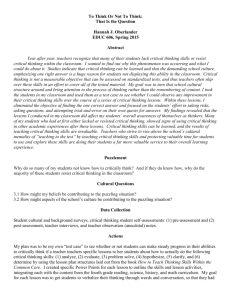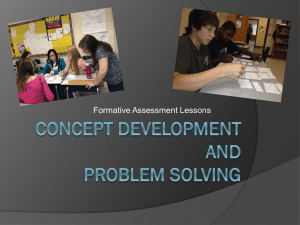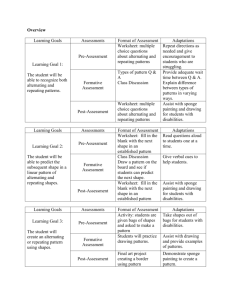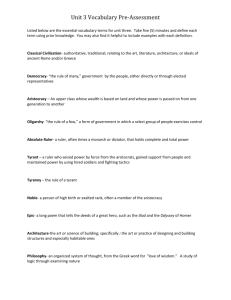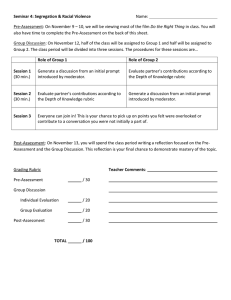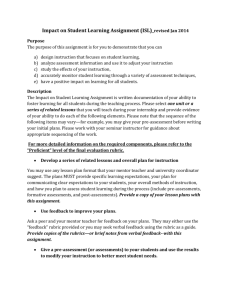Impact on Student Learning Assessment for Secondary Social Studies
advertisement
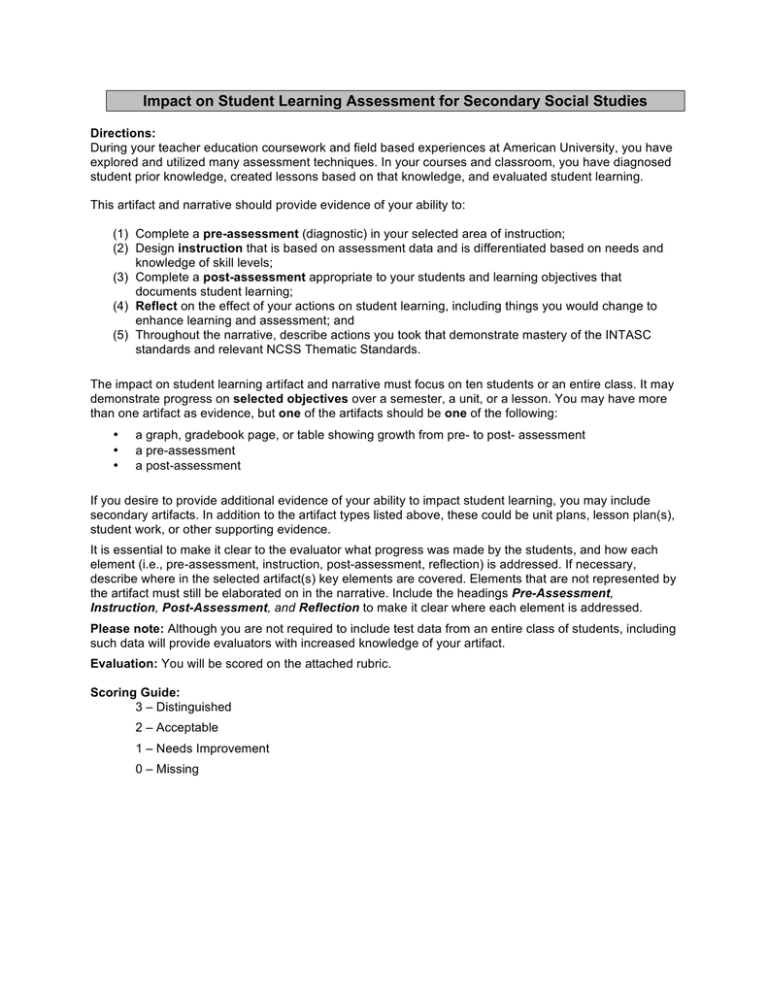
Impact on Student Learning Assessment for Secondary Social Studies Directions: During your teacher education coursework and field based experiences at American University, you have explored and utilized many assessment techniques. In your courses and classroom, you have diagnosed student prior knowledge, created lessons based on that knowledge, and evaluated student learning. This artifact and narrative should provide evidence of your ability to: (1) Complete a pre-assessment (diagnostic) in your selected area of instruction; (2) Design instruction that is based on assessment data and is differentiated based on needs and knowledge of skill levels; (3) Complete a post-assessment appropriate to your students and learning objectives that documents student learning; (4) Reflect on the effect of your actions on student learning, including things you would change to enhance learning and assessment; and (5) Throughout the narrative, describe actions you took that demonstrate mastery of the INTASC standards and relevant NCSS Thematic Standards. The impact on student learning artifact and narrative must focus on ten students or an entire class. It may demonstrate progress on selected objectives over a semester, a unit, or a lesson. You may have more than one artifact as evidence, but one of the artifacts should be one of the following: • • • a graph, gradebook page, or table showing growth from pre- to post- assessment a pre-assessment a post-assessment If you desire to provide additional evidence of your ability to impact student learning, you may include secondary artifacts. In addition to the artifact types listed above, these could be unit plans, lesson plan(s), student work, or other supporting evidence. It is essential to make it clear to the evaluator what progress was made by the students, and how each element (i.e., pre-assessment, instruction, post-assessment, reflection) is addressed. If necessary, describe where in the selected artifact(s) key elements are covered. Elements that are not represented by the artifact must still be elaborated on in the narrative. Include the headings Pre-Assessment, Instruction, Post-Assessment, and Reflection to make it clear where each element is addressed. Please note: Although you are not required to include test data from an entire class of students, including such data will provide evaluators with increased knowledge of your artifact. Evaluation: You will be scored on the attached rubric. Scoring Guide: 3 – Distinguished 2 – Acceptable 1 – Needs Improvement 0 – Missing Social Studies Impact on Student Learning Scoring Rubric 3 Standards Alignment Introduction PreAssessment Instruction PostAssessment Reflection Narrative Graphs 2 1 0 Content, skills, and performance standards are high and in alignment ! ! ! ! with state standards • NCSS standards are designated at the beginning of the Impact of Student Learning and are clearly evident throughout, reinforcing both the content and pedagogical strategies of the assessment • The work in the ISL centers on significant topics, issues, and/or problems that are oriented through the essential questions and daily instructional goals • The ISL employs methods of inquiry across different types of evidence and source material that are consistent with the social studies field(s) being taught • The ways in which the assessments are used in the ISL assist students in higher achievement and a better understanding of the tested standard(s) The selections that were made for this project are clearly identified and ! ! ! ! explained • Teachers explain how the standards, skills and lessons were chosen • Teachers explain how the group(s) of students who are being studied were chosen • Grade levels, course titles, and school district are shared • Strengths of students within the identified group are shared to build a better understanding by the evaluator of the tasks undertaken by the teacher • Challenges of students within the identified group are shared to build a better understanding by the evaluator of the tasks undertaken by the teacher The Impact on Student Learning contains a pre-assessment for the ! ! ! ! identified standard(s) above • The pre-assessment uses appropriate strategies to measure objectives • Explains how the pre-assessment reflects one or more NCSS Thematic Standards • Provides adequate details • Includes a discussion of pre-assessment results • Includes the pre-assessment itself and an answer key (with answers/rubrics) Description of instruction as it relates to the Impact on Student Learning ! ! ! ! is aligned to the NCSS standards • Promotes student learning • Employs appropriate strategies to support students in reaching objectives • Connects to pre-assessment data • Teaches one or more NCSS Thematic standards • Explains in detail what steps will be taken to teach and re-teach to help students achieve growth and mastery • A minimum of three lesson plans (using the Lesson Plan Analysis and Implementation Form) are included to illustrate how these goals will be retaught • Addresses the diverse needs of learners by providing multiple opportunities for students to interact with the material in multiple ways Description of the post-assessment as it relates to the Impact on ! ! ! ! Student Learning is aligned to the NCSS standards • The post-assessment uses appropriate strategies to measure objectives • Explains how the post-assessment reflects one or more NCSS Thematic Standards • Provides adequate detail • Includes a discussion of post-assessment results • Includes the post-assessment itself and an answer key (with answers/rubrics) The unit is logical for the student and for other teachers ! ! ! ! • Describes the impact of action on student learning as it relates to relevant NCSS Thematic Standard(s) and selected objectives The narrative is included to cohesively draw together each of the parts ! ! ! ! of the Impact on Student Learning Assessment • Progress made by the students is clearly articulated in each element of the narrative • Each section of the narrative is clearly labeled (introduction, pre-assessment, instruction, post-assessment, reflection) • Each handout to be included with the narrative is clearly labeled (introduction, preassessment, instruction, post-assessment, reflection) A minimum of two graphs/data charts are shared to interpret the data ! ! ! ! • The graphs/data charts are titled • The data can be clearly interpreted • Graphs/charts are identified with correct labels 3 ! 2 ! 1 ! 0 ! Parameters The overall parameters for the Impact on Student Learning have been met: • The ISL will accommodate a small group of at least ten students or more • Complete citations for all materials used in the ISL are provided Form: The form, style, and the mechanics of the Impact on Student Learning ! ! ! ! are correct and enhance the presentation of the material • Sentences are correctly structured, begin in a variety of ways, vary in length, and include compound and complex forms • Ending marks, quotation marks, apostrophes, commas, and parentheses are consistently used to enhance meaning or add effect • Spelling is correct

